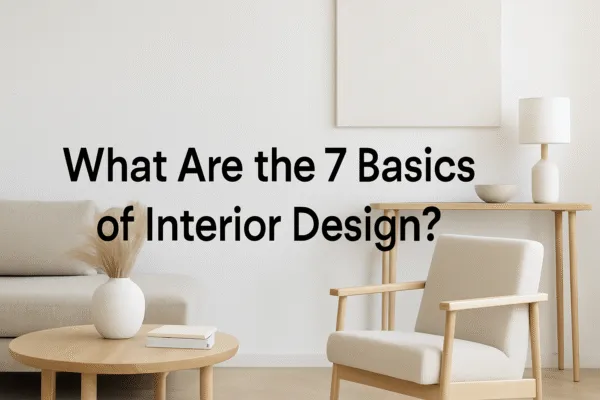
What Are the 7 Basics of Interior Design?
Introduction
Interior design is both an art and a science. It’s about more than decorating a room—it’s about creating spaces that feel balanced, functional, and inspiring. To achieve this, designers rely on seven fundamental principles. These basics provide the framework for building beautiful and livable environments.
In Palm Desert, CA, where modern desert elegance meets luxury living, hiring the best interior designer in California ensures these principles are applied thoughtfully. Whether for a luxury home, a vacation property, or a commercial space, mastering the seven basics of interior design guarantees results that blend style with function.
The 7 Basics of Interior Design
1. Balance
Balance is about distributing visual weight in a room so that no single area feels too heavy. There are three types of balance:
Symmetrical balance: Mirror-like arrangements, often used in traditional interiors.
Asymmetrical balance: Different but visually equal objects, common in modern designs.
Radial balance: Elements arranged around a central point, like a round table with chairs.
In Palm Desert homes, the best interior designer in California often uses balance to make open layouts feel both airy and grounded.
2. Rhythm
Rhythm in design is about creating movement for the eye. Just as music uses beats and patterns, design uses repetition, contrast, and progression.
Repeating shapes, colors, or textures.
Alternating light and dark tones.
Gradually changing size or color for flow.
This keeps spaces from feeling static and creates harmony throughout a home.
3. Harmony
Harmony ensures that all the elements in a room work together. While variety adds interest, harmony creates unity.
Colors that complement each other.
Materials that reflect the same style.
Repeated design elements across different rooms.
A skilled best interior designer in California knows how to bring together furniture, décor, and architecture into a cohesive vision.
4. Proportion and Scale
Proportion relates to how elements compare to each other, while scale relates to how they fit within the room.
A massive sofa in a small room looks overwhelming.
Tiny artwork on a large wall feels underwhelming.
The golden ratio (1:1.618) often guides these decisions, helping achieve timeless appeal.
5. Emphasis (Focal Point)
Every room needs a focal point—a feature that captures attention.
Living room: a fireplace or statement sofa.
Bedroom: a bold headboard or oversized artwork.
Dining room: a chandelier or dramatic table centerpiece.
The emphasis prevents a room from feeling cluttered by giving the eye a natural starting point.
6. Contrast
Contrast brings excitement and visual interest. It can be achieved through:
Light vs. dark colors.
Smooth vs. rough textures.
Modern vs. traditional shapes.
In Palm Desert interiors, contrast often comes through natural stone against sleek glass or desert-inspired warm tones against neutral palettes.
7. Details
The finishing touches are what transform a house into a home. Designers pay attention to small elements like:
Stitching on upholstery.
Hardware finishes on cabinetry.
Accent pillows, rugs, and artwork.
Details elevate the overall design and make a space feel complete.
Applying the 7 Basics in Palm Desert, CA
Palm Desert’s unique lifestyle blends desert landscapes with luxury living. Applying these seven principles ensures that homes and businesses reflect both comfort and sophistication. The best interior designer in California adapts these fundamentals to:
Maximize natural light.
Use sustainable materials.
Blend indoor and outdoor spaces.
Create timeless yet modern environments.
Why These Basics Matter
Create Functionality: Ensure spaces are livable.
Enhance Beauty: Provide aesthetic appeal.
Add Value: Professionally designed homes often appraise higher.
Reduce Stress: A balanced, harmonious environment promotes well-being.
Save Money: Prevent costly design mistakes.
Conclusion
The seven basics of interior design—balance, rhythm, harmony, proportion and scale, emphasis, contrast, and details—are the foundation of great design. By mastering these, designers create spaces that are not only beautiful but also functional and timeless.
For homeowners and businesses in Palm Desert, CA, working with the best interior designer in California ensures these principles are applied with creativity and precision. The result is an environment that reflects both the elegance of desert living and the universal standards of timeless design.
10 Frequently Asked Questions (FAQs)
1. What are the 7 basics of interior design?
They include balance, rhythm, harmony, proportion and scale, emphasis, contrast, and details.
2. Which is the most important principle?
Balance is often considered the foundation, though all are interdependent.
3. Do all designers follow these rules strictly?
Not strictly—designers adapt them creatively to fit the client and project.
4. Can homeowners apply these basics themselves?
Yes, but professional expertise ensures they’re used effectively.
5. Why hire the best interior designer in California?
Because they blend creativity, technical knowledge, and industry experience.
6. How does rhythm apply in real homes?
Through repeated patterns, colors, or shapes that create flow between rooms.
7. Do these principles change with trends?
No, they’re timeless; trends only change how they’re applied.
8. Can these rules be applied in small spaces?
Absolutely—especially proportion and scale, which are vital in compact rooms.
9. Do Palm Desert designers use contrast often?
Yes, they frequently balance natural desert tones with bold, modern accents.
10. Are details really that important?
Yes, details tie the entire design together and create polished, finished spaces.



